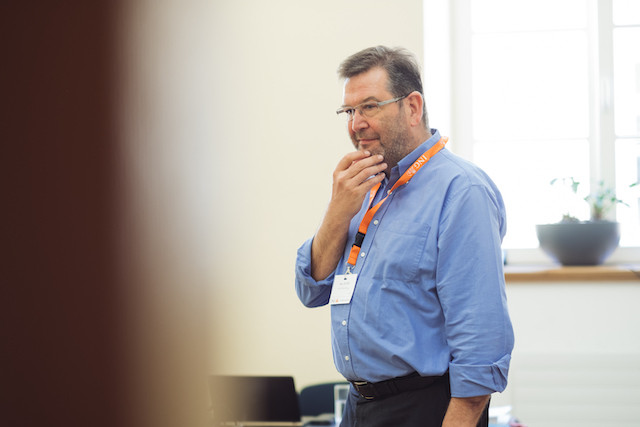Jess Bauldry: Tell us more about the technology and how it came about.
Marc Jacobs: People tend to touch masks all the time and move them, you name it. If your mask has been contaminated on the outside by the environment or other people it means you’re at constant risk of infecting yourself and other people.
It was identified as a real issue by several hospital directors in Luxembourg. They said if you can really develop a technology that could basically ensure that you deactivate the viruses within minutes of them landing on the outside of the mask that would be of real value in the fight against covid.
We’ve developed technology that allows us to put a thin layer on the material used to make surgical masks that will enable new means to deactivate any viruses that land on it.
How safe is this technique?
We don’t want to kill the virus and damage the wearer of the mask. That would be crazy. The beauty of the solution we’re working on, and for which we filed for CE certification at the health ministry last week, is that the final chemistry we use is citric acid, lemon juice essentially. It’s a very powerful virucidal compound and it’s super safe.
We also eat and drink it all the time. The amount we put on a mask is hundreds and hundreds of times lower than what you eat in a normal day. So, the risk from that perspective is zilch. The uniqueness of our technology is we put a layer of thickness of less than one thousandth of the thickness of a hair. We bind the acid to the material so it doesn’t leach out or go away.
When do you expect it to reach the market?
We don’t make the masks. Our customers are the people who make the masks. We’ve proven capability on the development front, but there’s still work to be done on scaling up and industrialisation. I think the first customers will be on the market with masks early next year.
I understand that you based this on technology patented since MPG was founded in 2016. Tell us more…
Our technology in essence was always to reprogramme the chemical composition of any surface and put down a very thin layer, we’re talking one thousandth of the thickness of a human hair, we’re in the nanometre range.
Let’s say we want to glue Teflon onto something. The whole point is nothing sticks to Teflon. But, there are plenty of applications where one would like to have Teflon functionality but you want to glue Teflon film onto substrate. Today that’s extremely difficult. There are ways to do it, but it takes a lot of aggressive and harmful chemicals. Our solution is completely environmentally friendly. No solvents. Hardly any energy. It’s as clean as you can get. The core of our technology is to graft a different functionality to enable things like that. We’re not gluing, we’re enabling the gluing.
So, you weren’t thinking about medical applications before this year?
Not at all. We were focused on aviation and industry. But in 2018, we did a proof of concept with the University of Leuven where we showed we could put complex molecules, we’re talking antibodies, on a substrate using our technology.
The big “so what?” in that is that today, putting an antibody down is the beginning of diagnostic test. Making that test in an additional manufacturing process, a multi-step chemical process that takes 24 to 72 hours just to put an antibody down. We do it in 10 seconds. It opens enormous possibilities for the future of diagnosistics.
Based on that, we participated in the first Fit4start health tech programme at the end of 2018. That created a roadmap for us to look into the healthcare sector. Today we’re working with big names. One of them is close to going to market. I can’t say more. This gave us the confidence with this virucidal stuff.

Marc Jacobs is pictured at the Paperjam Club Startup Stories event in October 2020. Photo: Julian Pierrot/Maison Moderne
How has this transformed your business focus?
I was reasonably confident it would be possible so in March [2020] I pivoted the entire focus of the company. Three quarters of the resources of the company were focused on the virucidal element for the entire summer. What we achieved in nine months is something you normally achieve in two to three, maybe four, years.
How permanent is this change of direction?
It’s not a temporary thing. This has created a strong foundation for us to develop our healthcare pillar much faster than we would otherwise have done.
To put it in rough numbers, probably in 2019 and even 2020, maybe 15-20% of what we did was in the healthcare sector. I expect next year it will be at least 50% and probably growing.
In the meantime, since September quite a few of our industrial projects have also picked up again. At lot of things were put on hold until after the summer, roughly six months. I’m talking automotive, electronics, aviation. The company will continue to develop on two main pillars, one being healthcare and the other being general industry. Where healthcare was in its infancy until now, what this does is to catapult it to at least a 50% position in the company going forward.
And your team, how have they been impacted?
We’ve increased staff by 50% the last nine months, it means we hired six people, mostly scientists and engineers to really drive the development work. And then also two people more on the business development side, both senior executives from Dupont. They joined us because they believe in the future of the technology and they have a background on the medical side, packaging and PPE, which is linked to what we’re doing here. They come with a very valuable skillset for us.
